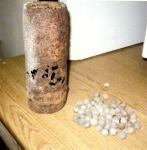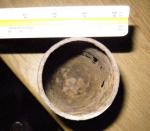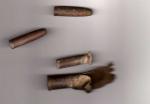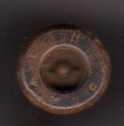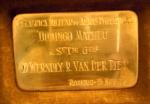
Thomas Symmonds
Past Contributor-
Posts
252 -
Joined
-
Last visited
Content Type
Profiles
Forums
Blogs
Gallery
Events
Store
Everything posted by Thomas Symmonds
-
Republic of Ireland Irish War of Independance
Thomas Symmonds replied to Danny70's topic in Northern European & Baltic States
Welcome James. I am sure you will enjoy these blokes and their kowledge as much as I have. As a relatively newbie myself welcome too to the waters of nothing-is-too-big-to-post. You'll figure it out I'm sure, trial and error, but start by getting the resolution down to about 150 and work on the target size - 110 x 100 or something close to it. BUT BEWARE THAT THE EPSON-EERS DONT CATCH UP TO YOU! regards Thomas -
Hello Gentlemen, thank you for your input Mervyn and Peter. Closer inspection of the base of the cartridge casing seems to me to show, going clockwise from top, "R" , "Broad arrow (?)", "L", "11" or "II" , and a "C". Any takers on an ID? Mervyn, from the two diagrams I would be inclined to go with the 15 pounder, Mark VI. The general shape seems to fit, and I have found what appears to be the "steel disk" which fits over the "tin cup" which I assume used to hold the expolsives. I say "used to" because I am still here even after dropping the thing upon reading your post! Unfortunately the base is too corroded to read. The shell, shrapnell, bullets and cartridge case were found on a farm called Protea Heights, just outside Stellenbosch, about 40 years ago. They were picked up by a man named Fred Stephens. It is with his passing that these items have found their way to me so unfortunarely the trail runs cold there. Maybe a little bit of help as to if any battles were fought there abouts, or troops perhaps stationed there ?? Thanks for the information so far. regards Thomas
-
Hello Will, & gentlemen. I have a WWII set that I hope you dont mind me posting. The set is attributed to one Mr Henry Parking, and as in your post the surname is probably adoptive. I have found out that Henry is of the Morolong Tribe, and that his Headman at the time of enlisting was Moroke. What I found intriguing was that our man only applied for his medals 34 years after being discharged, and only because of the insistence of the Secretary of the South African Legion in Parys (town in the Orange Free State at the time). The Certificate of Service is dated March 1980! A very interesting thread. Lets keep it going. regards Thomas
-
Mervyn, as always, very interesting and informative topic. A question though; I can imagine that the first pattern top hat, the one with the cane framework, must have been heavy, but at least it had a function. I struggle to understand why the police helmet patterns that followed are, in my opinion, more decorative than functional. Even in the current day example, I would imagine it must be very difficult to run a fast hundred meters. So the question is, why the cumbersome headgear? best regards Thomas
-
Hello all. These were handed to me today with a request to find out what I can. So I post them with the same request, "Any information will be greatly appreciated". The shell is 190 mm x 70 -75 mm diameter (It has rusted through in places). The lead shot are on average 13mm diameter. There are some markings on the case, not very clear on the photo I'm afraid. I think they are 0 - 75 - ? (what looks like) R1 F (3) or (5) or (8) ? (3) or (2) L 6 . 2.16 U Sorry all very unclear And then some bullets (30 mm x 7 mm) and a bullet shell (55 mm x 13 mm)... Thanks gentlemen. Regards Thomas
-
Presentation Bayonet. (Translation please)
Thomas Symmonds replied to Thomas Symmonds's topic in Swords & Edged Weapons
Thank you Richie, and yes you are quite correct - it is not a bayonet. It has been a bayonet day for me today and the word just seems to have stuck. Googling is very addictive when one is on a trail ... this is by no means definitive, and could even be totally wrong, but that is what makes collecting and searching for provenance great! This is quotation is from "South African Military History Society - Journal - PIET BOTHA - A SOUTH AFRICAN PATRIOT" "Major W R van der Riet, MC, ('Booysie' to his men), was promoted to command of the battalion when Lt Col Bester was promoted to Brigadier. He retired in 1974 from the SADF as Chief of Defence Staff with the rank of Lieutenant General." The game is on! Thanks again for the translation. Regards, Thomas -
Hello all. Sorry, this thread seems to be hoping around a bit as the replies and questions come in. Back to the Yatagan pattern ... Mervyn you might remember this one. This is the 1856/58 bayonet. It differs from the one mentioned earlier in that it has no hooked quillon. I am not sure wether they ever came out with hooked quillons (?). It misses out being a perfect 1856 because the leaf spring is attached by a screw rather than a rivet. regards, Thomas
-
Hello Gentlemen. I recently picked up this lovely presentation bayonet still in its wooden box. It has "FABRICA MILITAR DE ARMAS PORTATILES 'DM' ROSARIO D.G.F.M. INDUSTRIA ARGENTINA" on the blade followed by FM inside two circles. (I am assuming its made in Argentinia, and the language is Spanish?). The plaque inside the lid reads, " La Fabrica Militar de Armas Portatiles Domingo Mateu al Sr Tte Gral D. Werndly. R. van der Riet Rosario - 15 Nov - 72" Any help here would be very much appreciated. ID on the bayonet?? Regards, Thomas
-
Hello Gentlemen, A bayonet from my collection, pictured below, might not be particularly rare, (it is a shortened Italian "baionetta" M1870 known as the 1870/15), but I am interested to know if anyone has an original full / un-shortened version to show. Most of the 1870 & 1870/87 patterns were shortened during WWI as they were considerd to long and unwieldly (blade length of 517mm). The hook quillons were shortened too. A first pattern scabbard to show, mine's a second pattern, would be great too. regards, Thomas
-
BRITISH SOUTH AFRICAN POLICE CAP
Thomas Symmonds replied to Mervyn Mitton's topic in Police Forces of the World
Mervyn, you really do manage to get some thoroughly enjoyable threads going. I do enjoy a good chuckle in the mornings too. :lol: -
Hello all. What are the chances of this ending up in my little town of Somerset West, Western Cape, South Africa? I needed a clock for above the fireplace too. The photo of the clock face is not great, but it says " SMITH'S CRICKLEWOOD, N.W.2" I have found out that after being badly damaged in an aerial attack in 1942 she underwent repairs and refitting in Rosyth, Scotland. So the dates work. It says that she was finally dismantled for scrap in 1958 after six years in reserve status, after having been decommisioned in 1952.
-
RHODESIAN ASST. COMMS. SWORD
Thomas Symmonds replied to Mervyn Mitton's topic in Swords & Edged Weapons
Hello all, Jonathan is correct in his info on Richard Milner. The information comes in on a "Richard Milner Ltd" letter, email address richard@armsresearch.co.uk I have just received info back on a sword that I have. It turns out to be an infantry sword to the Southern Rhodesian Gov. On the page that it is listed, (it is numbered 83101), numbers 83098 to 83104 are all sold to the Southern Rhodesian Gov. The date of sale is the same for them all, 14-06-61. Unfortunately more information than that they cannot give me. Anyone know where we can find information on the swords once they reached Rhodesia? regards Thomas -
Hello Jonathan. I noted that you used "Pecard antique leather dressing" on the scabbard of one of your swords. I am keen to know how you go about cleaning and "preserving" your swords and scabbards. Product names and materials particularly. You come across as some one who takes a great deal of care, and has alot of pride in their pieces, so I know your advice here must be valuable. regards Thomas
-
Fantastic research Jonathan. Would it not be great to be able to reunite sword and medals? Would you ever consider that, (have you done something along those lines before)? Do you do a little research before you decide to make a bid to purchase a sword, or is it perhaps the sword itself that might first attract you? I look forward to more swords with stories. regards, Thomas
-
Great swords. I look forward to your write ups. Thomas
-
Three generations
Thomas Symmonds replied to Thomas Symmonds's topic in Great Britain: Orders, Gallantry, Campaign Medals
Those are great! I can almost see you, chest out, proud as punch. I notice yours and your son's are court mounted, and your father's not. I still have not decided which style us my favourite.Although court mounted does look grand, the original way of wearing (perhaps being a traditionalist) just, but only just, gets my nod. Are the medals framed in any way? Do you display them? Thanks for sharing. regards Thomas -
Hello Darrell, thanks for posting your collection, i especially have enjoyed following your thread to see new arrivals. I have a few myself, but as Mervyn mentioned it is rather difficult to come by QSAs over here in SA at the moment. You mentioned in your thread that you wanted to collect all clasps, then in your last post you mentioned 23. I cant find my medal book just yet, but aren't there 24, plus 1901 & 1902? regards Thomas
-
Three generations
Thomas Symmonds replied to Thomas Symmonds's topic in Great Britain: Orders, Gallantry, Campaign Medals
I look forward to that. :) -
Three generations
Thomas Symmonds replied to Thomas Symmonds's topic in Great Britain: Orders, Gallantry, Campaign Medals
-
Three generations
Thomas Symmonds replied to Thomas Symmonds's topic in Great Britain: Orders, Gallantry, Campaign Medals
grandpa was W. Melville (medals stamped "DVR W. T4-037653 A.S.C.) son was/is W.C Melville (medals stamped " W.C. 175553) grandson was/is I. Melville (medals stamped "CPL I. 24048471 SG) -
Hello all, Mervyn, you might remeber these. The Victory Medal is unfortunately not the original, but it completes the set nicely. The QSA has the (some times prized "ghost dates") I have a few two-generation sets of medals, but this is my only three-generation one. Any body else have three-generation, or more!, sets? regards Thomas




